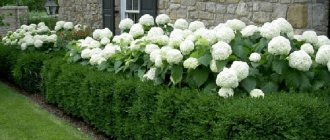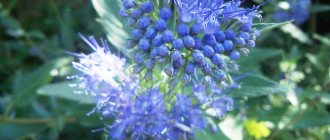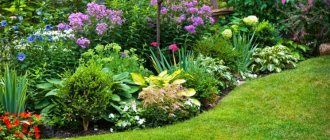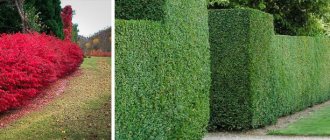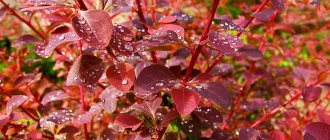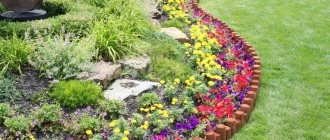Plants on the site can serve not only as a decorative component, but are also capable of performing certain functions. Cover up unsightly outbuildings, stabilize the soil or divide the area, for example. Today we will talk about deciduous shrubs that are suitable for forming a hedge. A hedge in a dacha is plants densely planted in one chain for decoration and dividing space into certain zones, to replace a traditional fence, and to protect the area from prying eyes or even to protect the garden from wild animals.
Regardless of the purpose of a hedge, it is a very beautiful ornament that can transform any landscape.
Advantages of a hedge:
- As we said above, a hedge can divide a site into certain zones. For example, it can be used to separate central areas from the adjacent area. Or a vegetable garden area from an orchard.
- A living wall can easily replace the fence we are used to. If you decide to delimit the territory with something other than a traditional stationary fence, densely planted crops will easily hide your garden from prying eyes.
- If your site is already fenced, but the fence is unattractive, or maybe just old, hedges will also come to the rescue, creating a picturesque backdrop
- The same rule applies inside the garden. By planting a dense hedge along buildings, you can hide unattractive walls and give the overall landscape a neat look.
- By choosing deciduous crops with thorns (for example, hawthorn) to build a living wall, you can not only decorate the garden, but also protect it from uninvited guests - wild animals.
- A dense growth of deciduous shrubs planted in a row will perfectly protect the area from the scorching sun and strong drafts
- If your site has recreational areas, a hedge can make these corners not only cozy, but also add coolness and shade on especially hot days. A great place to hide from the hustle and bustle while reading your favorite book!
- Of course, planted plants make the garden more presentable, add color to it and make the air much cleaner
- If you choose lush flowering plants for your hedge, they will become excellent honey plants and will attract beneficial insects to your garden.
- Strengthening the soil. To prevent water erosion from harming the soil cover, it is necessary to think about strengthening it. A turfed slope is one of the required elements in the case of predominant heterogeneous terrain. Dense plantings of shrubs will come to the rescue in such a situation.
Having examined the main functions of a hedge, let’s proceed to choosing plants. Since our goal is a thick, as if animated wall, performing the tasks of zoning, protecting and hiding the garden from prying eyes, the plants must be selected at a certain height: from one and a half meters. The second criterion for the selected seedlings is that they must be fast-growing shrubs for hedges, so that within a couple of years they will create a dense, lush fence.
Conventionally, hedges are usually divided into 2 types: homogeneous and mixed. The first ones are created from one type of plant (a bright and thick living wall of barberry, for example), while the mixed ones alternate several types (for example, thuja, hydrangea, thuja, hydrangea, and so on).
Advantages of hedges
A living fence has so many advantages that every owner of a plot of land will definitely want to plant a green hedge.
Advantages of green fencing:
- A green hedge made of bushes will replace a fence designed to divide the internal territory into zones.
- A green fence looks more picturesque than artificial fences.
- A wall of greenery will protect from the wind, but will allow streams of fresh air into the area.
- Green plantings on the site will not suffer from drafts; the bushes muffle the whirlwinds.
- Bushes with a dense crown make the air in the area fresh and absorb unnecessary sounds.
- Flowering plants smell pleasantly aromatic, uplifting your mood.
- Planting is easier than putting up a solid fence.
- Protects the area from prying eyes.
- Masks an ugly building in a country house.
- Plays as a bright accent in the landscape design of the site.
- Flowering shrubs will attract bees, which will help pollinate garden plantings.
The only downside to a living fence is its maintenance. But there are many shrubs that will serve as a hedge for a long time and will not require special care.
Location
A striking red leaf hedge will do well in a clean, open space exposed to sunlight.
A spectacular hedge on your property
In a dark place, such bright foliage will look gloomy. This applies, for example, to some varieties of European beech or cultivated cherry plum. Plants with golden needles will appear dull on hot days. To avoid unexpected effects, it is better to choose species with bright green leaves.
It is customary to use not only planting shrubs
- Due to their bright foliage, maples will decorate your site in the autumn. Among the Far Eastern species, it is worth noting the Manchurian ash, fluffy alder, and beautiful larch.
- Some hedges have thorns and thorns. On the one hand, this scares off some uninvited guests, on the other hand, it creates difficulties in regular maintenance.
- Don't ignore climbing plants either. They grow quickly in both sunny and shady corners of the garden. They entwine trellises, obelisks and pavilions specially built for them.
- Campsis with bright trusses of tubular flowers has proven itself well in landscaping. Pruned oaks, maples, and weeping lindens look great on the plots.
Such shrubs will add a good mood to your dacha
You have the power to turn your hedge into a sea of colors and flowers. You can buy ready-made wooden trellises covered with plants. In just one day, reliable protection from prying eyes will be ready.
Requirements for a hedge
A hedge in a dacha should not cause inconvenience to the owners, so there are some requirements for a hedge:
- The shrub must be fast-growing so as not to wait years for the “erection” of the fence. Fast-growing plants turn into a real hedge within 2-4 years.
- The choice should fall on shrubs that grow to the desired height and do not wither after pruning.
- For hedges, it is better to choose small-leaved shrubs. They are easier to shape the crown and shape.
- Plants must be resistant to drought, disease, lack of nutrition, and also frost-resistant, because they are difficult to cover for the winter.
- They must be thick to fulfill all the functions of the fence.
- Plants should not need frequent replanting and should grow strongly, taking over free areas of the garden.
- A hedge shrub can be spreading, with a voluminous crown, but it must have a limited size, beyond which it will not grow.
Creating a trellis fence
A trellis fence is a godsend for small areas. It is formed from willow, acacia, hawthorn, and rowan.
Trellis hedge
Step-by-step instruction:
1Seedlings are planted at intervals of 20 cm.
2After a year, the plants are pruned. Only a stump of about 15 cm is left.
3In the second year, pruning is carried out again. It is necessary to leave strong shoots and remove the rest.
4The left shoots intertwine with each other. You must maintain an angle of 45 degrees. The bark at the points of contact is removed.
5The diamond pattern needs to be secured. For this, a frame is installed.
6When side shoots appear, they need to be cut off. Pruning is carried out about 3 times during the season.
7To ensure that the hedge is of the required height, the tops of the trees are also trimmed.
Undesirable plants for hedges
When choosing plants for a hedge, it is worth excluding unwanted seedlings that grow so large that they take root throughout the entire area. The most famous root spreader is considered to be the Sakhalin knotweed.
This group also includes fieldfare, raspberry, shadberry, and blackberry. They send out their roots in all directions and send out shoots that fill the free space.
You should not plant bushes that are most often attacked by pests. These include viburnum. Even after treatment with chemicals, it can be attacked again by harmful insects.
Plantings that can freeze in winter are not suitable for hedges. After a harsh winter, the entire fence will have to be replanted. Those plantings that need to be replanted periodically also degenerate. Such bushes are also not suitable for a fence.
Landing
Hedge
Before planting hedge plants, you need to prepare the area. Think about what plants will make up the composition, or whether it will consist of one type of shrub.
Preparation of a personal plot
You need to start by marking the territory. It will allow you to plant plants evenly, at the same distance. This is done using a tape measure or pegs with a rope.
A trench is dug along the marks
The depth should be 40 - 60 cm. Depends on the root system of the selected tree or shrub. The width varies by the number of rows. For one row of plantings 60 cm is enough, for two rows 1 m.
Then the soil is prepared. Here you need to take into account the characteristics of plants to the soil. If necessary, a drainage layer of crushed stone is laid on the bottom. The soil is mixed with humus or other suitable fertilizers.
Disembarkation
Planting time depends on the planting material. It is better to plant cuttings in the spring. Shrubs grown in containers or transplanted from another site can be planted both in spring and autumn.
Planting a hedge
The soil is moistened. After this, disembarkation takes place. The distance between seedlings should be approximately 30 cm. It depends on the desired density of the hedge and the characteristics of the plant itself.
The formation of a hedge takes at least 2 years. During this time, the plants are already growing well, creating a dense wall.
Fast-growing hedges of uniform shrubs
If you need to create a reliable barrier, then perennial plantings are best. Fast-growing hedge shrubs will decorate any home area.
What to plant near the fence to hide it? Derain, barberry, hydrangea. It is important that the roots of the plant do not grow and knock down the fence. You can plant coniferous trees near the fence. A good option is spruce and decorative pine.
Hawthorn
All gardeners know hawthorn, and different varieties are used to create a wall. The tallest ones grow up to 6 m, but there are some that only grow up to 3 m.
The plant is attractive because, having a round crown shape, it looks aesthetically pleasing even without a haircut. Blooms luxuriantly starting in May. Looks beautiful at any time of the year, but especially in the fall when the foliage turns purple.
Bladderwort
It is distinguished by its unprecedented decorativeness, starting with the foliage, which resembles the beautiful leaves of viburnum. Some varieties have red or gold foliage.
The crown is thick, dense, rounded, with an abundance of foliage, so it can be cut to any shape.
It blooms in June, but retains its attractive appearance from spring to autumn. It does not require special care, easily tolerates frosts and dry summers, and is not afraid of pests and diseases. Grows on any soil, but does not tolerate waterlogging. You can plant it in the shade, but the color of the foliage will be less saturated.
Cotoneaster brilliant
The bushes grow up to 3 m in height, and the diameter of the crown can stretch up to 4.5 m. It is endowed with oval-shaped leaves. Cotoneaster is suitable for pruning to suit any shape.
It begins to bloom in May or June. For a whole month the bushes stand densely covered with pink inflorescences. And in autumn the foliage turns crimson, among which black fruits are visible. They last until frost.
Requires haircuts several times a season. It is not afraid of frost or drought, and is not susceptible to pests and diseases. Lives 50 years or more.
Snowberry
Among the unpretentious plants, snowberry stands out, which is often called “wolfberry”. The fruits are considered poisonous. White snowberry is more suitable for decorating the site, since it blooms for a very long time, from May to early autumn. Often white flowers are visible in winter. It is not afraid of shearing and grows on any soil.
Forsythia
The shrub blooms with golden stars starting in April. Foliage begins to appear after flowering. The bushes grow up to 3 m, the crown grows up to 2 m.
The splendor of flowering depends on the condition of the soil. The plant blooms well if planted on neutral soil. It is better to cover the plantings for the winter so that frost does not damage the flower buds.
Rose hip
Reaches 2-3 m in height, lives up to 50 years. Blooms for 20 days, starting in May. The flowers are most often pink, but they also come in yellow, white, red or cream shades.
As the rosehip grows, it forms impenetrable thickets with sharp thorns. It is not afraid of either frosty winters or dry summers.
Hydrangea
A beautiful shrub with large leaves blooms throughout the summer. Its amazing, large inflorescences can be of different shades. The color of the inflorescences depends on the composition of the soil. Even blue flowers can bloom on soils rich in aluminum.
It is better to cover it for the winter, but during drought it requires abundant watering.
Derain
Derain for hedges is the best choice. It reaches a height of up to 3 meters, and the crown can spread up to 5 meters in circumference. The shrub is famous for the fact that it remains decorative even in winter, due to the fact that the bark of the branches is scarlet.
It usually blooms twice per season, attracting pollinating insects. Grows quickly in any soil. Frost-resistant, but requires watering in dry summers.
Chubushnik
The shrub is often confused with jasmine. Spreading bushes bloom with beautiful large flowers. Cream or white flowers can be double, giving the plantings an unprecedented charm.
It is not afraid of pruning, tolerates frosts, and can grow in partial shade. However, for luxuriant flowering, plantings must be thinned.
Spiraea gray Grefsheim
In spring, this variety of spirea looks as if its branches are covered in white foam. Double flowers bloom so luxuriantly. In this unusual form, the bushes will last 1.5 months.
A spreading bush that grows 2-2.5 meters in circumference and height. You can cut it, or you can leave it in its natural form, its beauty will not be diminished.
Shrubs for this type of hedge can grow on any land, in partial shade, but you should not refuse watering. Honey plant. Bees gather a lot during flowering. As a rule, this is May or June.
Irga
A beautiful ornamental shrub - round-leaved serviceberry, from 1 to 4 m high, tolerates pruning well.
Numerous flowers grow in snow-white tassels. First the flowering clusters appear, and then the foliage. By autumn the game is covered with edible blue fruits.
Irga is not afraid of pests, is frost-resistant, and tolerates drought well. It produces a lot of growth that needs to be removed.
Cinquefoil shrub
The dense crown is easy to trim, giving it any shape. During flowering, it is covered with yellow flowers with a fluffy center. It blooms for a long time, starting in June and ending in October.
There are varieties of cinquefoil with red, white, pink, and orange inflorescences. An unpretentious shrub, it is not afraid of frosty winters, but will not survive dry summers, and therefore requires abundant watering.
Which plants to choose?
If you are creating a hedge with an eye to the future, take your time and do not buy the first shrubs you come across. When choosing a cultural variety, several factors are taken into account:
- When purchasing your chosen plant breed, find out how big it will grow . For example, different varieties of boxwood evergreen can vary significantly in height. It can reach only one meter in height, or it can reach a height of two and a half meters.
- Try not to choose plant species that are too tall, as gaps may appear in them . Be sure to inquire about the winter hardiness of the selected species. If they freeze, the desired effect will be very difficult to achieve.
Try not to choose breeds that are too tall
- Find out about the chosen plant, whether it is deciduous or evergreen . If you are outside the city only in the warm season, deciduous species are suitable, as they can change their appearance depending on the season. In spring – gently green hawthorn and linden, golden forsythia, in autumn – warm shades of maple and euonymus.
- Find out what kind of care the selected plant species require. For example, fast-growing thuja is pruned only twice a year, but not more often, and pruning of yew and boxwood should be done only at the beginning of summer. If you want stricter lines, cut it also in March. Evergreen shrubs with large leaves are trimmed only with hand pruners.
Before planting, you need to know everything about the plant.
Mixed fast-growing shrub hedges
To make a hedge look like a picturesque picture, you need to plant several varieties of bushes of different textures.
Coniferous and deciduous trees go well together. An example of a combination: juniper with blue needles and golden Thunberg barberry, red-leaved bladderwort and thuja with bright needles.
Bushes with leaves with edging look beautiful next to a crown in the same color, which repeats the same color of the edging.
You can plant bushes of the same height, or you can plant them of different heights to get a more decorative wall.
Care
A hedge requires maintenance. In order for it to have a well-groomed appearance, it needs to be trimmed, weeded, fertilized, and watered.
Hedge care
Feeding and watering are carried out with the intensity required by the selected plants. If the fence consists of deciduous plants, then regular watering is needed. Evergreen species are mostly drought-resistant and can be watered much less frequently.
It is recommended to apply fertilizers 2 times a year:
1 First time in the spring: at this time, preference is given to nitrogen-containing mixtures.
2 Second time in the fall: fertilizing should contain phosphates.
Evergreen hedges
Hedges made from evergreens have a significant drawback - they grow slowly, but they can be trimmed less frequently, and they retain their decorative appearance all year round.
Juniper
The bush grows 20 cm per year. It has a dense crown, the needles are firmly attached to the branch and do not fall off. The spreading species of this plant make a beautiful green border. And from cone-shaped varieties, an even fence of extraordinary beauty is obtained. It tolerates frost well and is not picky about the soil.
Boxwood
Deciduous low shrub with a very dense crown. In a year it stretches only 15-20 cm. It is thermophilic and needs shelter. Poisonous.
Thuja
A coniferous plant can grow 20-30 cm in a year. It lends itself to any cutting. There are two varieties grown in Russia - "Smaragd" and "Brabant" - as they grow well here.
"Brabant" grows quickly, spreading branches in all directions. "Smaragd" has a conical crown, which makes it possible to create high walls.
Kalmiya
The shrub is not tall, only 1.5 meters, and grows up to 30 cm in height per year. The crown is beautiful, dense, and does not require pruning. The plantings are toxic.
Kalmia flowers of different shades bloom in late spring. It is necessary to plant only on acidic soils. Does not require watering and tolerates severe frosts well.
Yew berry
Coniferous trees grow slowly and for a long time. A hedge of yew bushes looks especially bright when the red berries are ripening. They are poisonous, like all parts of this plant. Yew is durable, but can suffer from bright sun.
Lawson's cypress
The conical bushes are equipped with needles reminiscent of thuja needles. The greens have a bluish tint, so they seem to be covered with frost.
The plant can grow even on poor soil, but requires watering. Not susceptible to diseases and pest attacks. Does not like to grow in the shade.
Which ones are fast growing?
Vertical gardening is a universal garden decorator that allows you to achieve a stunning effect in a short time.
A flowering fence is beautiful at any time of the year
You need to start by selecting supports for the “green wall”, which should decorate the area even without vines. This is important in winter and spring, when supports serve as the only accents of the garden. The choice of plants for vertical gardening is quite rich.
The choice of plants for hedges is large and varied
- The girl’s grapes, which themselves “climb” the wall, look impressive. An unpretentious hop that prefers a shady corner looks beautiful. True, its growth will have to be controlled, otherwise it will displace other crops from the site.
- You can create a decorative green vertical from such annual vines as blood red beans, nasturtium, morning glory.
- Some herbaceous perennials can also create dense, variegated walls of flowers. Willow sunflower reaches two and a half meters, and rudbeckia and elecampane can grow up to three meters.
- For climbing plants such as roses, morning glory, clematis and others, it is advisable to build some kind of support, and do not forget to tie up the plants from time to time. Not all specimens need to be tied up.
Looks very impressive and floral
Plants such as Kobea and Campsis just need to be planted near the support. Blue delphinium flowers will delight you on a wall 1.7 meters high. Lavatera, hollyhock, and buzulnik can reach approximately the same height.
Frost-resistant shrubs for hedges
It is better to plant frost-resistant shrubs for hedges. After all, it is not always possible to cover them for the whole winter. For example, in the middle zone there are often thaws, from which the bushes begin to die. Therefore, you need to choose bushes that can withstand the coldest winters.
White dogwood Sibirika
The bushes can survive even -50°C. Grows well in partial shade and on any soil. The fence is suitable for Siberia and other regions with cold winters.
Thuja Smaragd
Tall thuja, growing up to 2.5 m, can withstand even minus 40°C. Does not tolerate lack of lighting, dry periods, and is afraid of drafts. Grows well in partial shade.
Highbush blueberry Pink Blueberry
Grows up to 2.5 m. Not afraid of frost, but requires a lot of light, well-fertilized acidic soil.
Barberry Thunberg
The low ornamental shrub tolerates frosts down to -30°C without damage to its development. Grows in partial shade and on any soil; limestone soils are most useful.
Yews
Long-lived, do not freeze even at -35°C. But trees cannot stand strong winds; they can destroy them.
Yews do not tolerate stagnant water, but they grow well on neutral loams or sandy soils.
Cypress trees
A perennial fast-growing shrub capable of growing up to 10 m. Frost resistance down to -30°C.
They grow well in a sunny area, but can also thrive in partial shade. Prefers acidic fertilized soil.
Weigela Eva Rathke
The low frost-resistant plant can suffer from heat and does not like either dry or moist soil.
In regions where summers are hot, you can plant it in the shade so that the fence grows well.
Hedge trimming
When planting deciduous plants, the first cutting is carried out to stasis. Leave stumps of approximately 15 cm . This will allow the side shoots to grow more luxuriantly.
It is necessary to consider what seedlings are planted. With the root system exposed, half the length of the plant is left. If a bush grown in a container is planted, pruning is done to one third of the height.
To carry out caring procedures, garden shears, pruning shears or electric cutting tools are used.
In the second year of growth, 4 prunings are carried out at monthly intervals. Starts in May and ends in August. Pruning should be easy. It is aimed at creating the density and shape of the planting.
Very strong pruning is needed for hedges made of privet, hawthorn, and thorns. 15 cm of the plant is left above the soil surface. In dogwood, boxwood, barberry, and beech, new shoots are shortened by a third of their length.
But juniper and cypress do not need such a radical procedure. They only cut off branches that stand out from the general mass and disrupt the neat appearance.
When forming a hedge, you need to leave a wider base. Than the top. That is, it is given a trapezoidal shape. This will allow low branches and leaves to receive enough sunlight.
In all subsequent years, light preventative pruning is carried out. It helps preserve the decorative appearance of the hedge.
It is recommended to trim deciduous plants in the spring before the leaves appear. Conifers - can be pruned both in spring and autumn.
Shrubs that do not require regular trimming
Among the shrubs that are good even without cutting, one can name Kalmia. Blooms beautifully with lush flowers. An evergreen plant with amazing flowering.
Spiraea Vangutta is covered with white flowers in spring. Grows quickly in any soil, in the shade or in the sun.
Caragana with golden flowers is often chosen for planting in uneven areas. Grows in any soil and does not require careful care.
Cotoneaster multiflorum, holly and others
We can safely say that a cotoneaster hedge can satisfy almost any taste. It is not picky about soil and moisture, however, in the first year of cultivation it requires timely watering. There are quite a few other varieties that are very often used in the construction of green fences:
- Cotoneaster multiflorum. It can reach 2-3 m. The leaves are silver-green in spring, dark green in summer, and turn red in autumn. The flowers are white, collected in dense corymbs. Bright red berries decorate the bush from August to late autumn. Less frost-hardy, but more light-loving than brilliant cotoneaster.
- Holly . Just like brilliant, it comes from Northern China. The flowers are red and the berries are black, remaining on the bush until the next harvest. The leaves are glossy, dark green in color. A worthy representative of his family.
- Cotoneaster is entire . Shiny rounded leaves and bright red berries make the hedge very elegant. Not picky about soil. All this together makes it very popular among lovers of beautiful green fences on their site.
- Willow leaf . This comrade is distinguished by rather long, pointed, wrinkled leaves. The flowers are white-cream, fragrant. It usually reaches four to five meters in height, so it can safely boast of an excellent opportunity to hide your entire site from unwanted views behind your wall.
- Spreading cotoneaster. Two-meter bushes with long clusters of white flowers in early summer and red berries in August-September, coupled with shiny dark green leaves, look very elegant throughout the season.
Advice! All types of cotoneasters can be grown from seeds, but to get quick results it is better to plant cuttings or layering.
By region of Russia
Different climatic zones require different shrubs:
In the Moscow region, the following will grow well: thuja "Brabant", bladdercarp, cinquefoil, cherry laurel, brilliant cotoneaster, hawthorn, privet, Alpine currant, deutzia, boxwood, spirea, hydrangea.
For the Leningrad region, the best shrubs for a green fence will be: juniper of all types, blackberries, barberry, hawthorn, viburnum “Snowball”, rose hips, sea buckthorn, sloe, mahonia, privet.
It is best to create a hedge in Siberia from such plantings as:
- Siberian hawthorn,
- Thunberg barberry,
- white derain,
- rose hip,
- gray rose,
- forsythia,
- spirea,
- honeysuckle,
- lilac,
- crown mock orange.
In the Urals you can plant a fence by choosing plants such as
- mahonia,
- red-leaved barberry,
- euonymus,
- spirea,
- spruce,
- turn,
- snowberry,
- hawthorn,
- white derain,
- barberry,
- vesicular carp,
- irga,
- rock juniper.
Euonymus Fortune
An extremely low-growing, ground-growing shrub with light green leaves with a white border.
- Drought-resistant, tolerates pruning well.
- The emerald foliage of the euonymus turns purple-red in the fall.
- Additional charm is given by the fruit-boxes of an unusual shape, which acquire a rich color by autumn.
Almost all types of euonymus are shade-loving shrubs for hedges , but there are also varieties that are resistant to bright light. In 2-3 years, Fortune's euonymus will help create a luxurious fence just over a meter tall.
Loves watering and nutrient-rich soil with a neutral reaction. However, it is worth noting that most varieties do not tolerate gas and dust.
With good care and timely feeding, it is exceptionally elegant.
Advice! If you have a desire to make a fabulously beautiful unique fence, then Fortune’s euonymus is the best choice. Propagated by both seeds and cuttings.
Planting, care, pruning
Planting a hedge should be done in fertilized, prepared soil, because the bushes will take many years to grow in one place.
Heavy clay soil must be dug up with sand, alkaline soil must be acidified with peat, and acidic soil must be dug up with dolomite flour.
Soil preparation is carried out in the fall, and plants should be planted in the spring so that they have time to take root before the onset of winter cold.
Planting a hedge
Planting a hedge should not be done by eye, as it may result in a crooked row. In the area where the green fence will grow, it is necessary to mark the rows using pegs and rope.
Next, you need to dig holes for each bush or one groove, approximately 60 cm deep. If you need to plant two rows of bushes, then the groove should be 100 cm wide.
Make the distance between the rows 50 cm, and between the bushes - 50-150 cm. Having lowered the roots of the seedlings into the hole, cover them with soil and water. Then water in the morning and evening until the seedlings take root. This will create a living fence.
Caring for it means watering and feeding. Fertilizing should be applied 3 times per season:
- In spring - nitrogen fertilizers (carbamite, ammonium sulfate or ammonium nitrate) 80 g per 1 sq. meter;
- In August - phosphorus and potassium (60-80 g of superphosphate and 30-40 g per 1 square meter of potassium nitrate);
- In autumn - compost or rotted manure for digging, 2-3 kg per square meter.
Plant care, haircut
When planting a living fence, check to see if the plant can withstand pruning in the first year. If he can’t, then start cutting hair only after 2 years. Sanitary pruning can be carried out at the following times:
- Deciduous shrubs planted in autumn are pruned after 6 months;
- Coniferous plantings - every other year, in August.
For deciduous bushes, the side shoots are shortened by 15 cm, and the top is trimmed so that the plant is only 40-45 cm in height.
The top of the coniferous tree is cut off by 10-15 cm, and the side branches by 5-10 cm, so that a dense crown is formed.
Then, every 3-4 years, remove a third of the growth that has grown over the year. As a result, the hedge will be dense and regular in shape.
In the future, prune 2-3 times a year in May, July and August.
With each pruning, it is recommended to retreat from the previous level, leaving the shoots 7-8 cm longer. As a rule, all bushes must be subjected to sanitary pruning.
If the seedlings bloom in the spring, then pruning is carried out immediately after flowering, and if in the summer - in the spring, then before the start of sap flow.
Thuja for hedges
Thuja is quite thermophilic, for this reason it is better to plant it in open ground in March. But in areas with not too cold winters, autumn planting can be done. In this situation, it is important to do it before the soil completely freezes, because the plant simply will not take root. The latest landing date is the second half of October.
The advantage of this plant is that it does not need too many additives.
How to plant?
When planting, it is advisable to place a couple of buckets of humus at the bottom of the hole; it must be connected to the top fertile layer of soil. In the spring, you need to add about half a kilogram of superphosphate to the same hole. If this component is not available, you can use a kilogram of wood ash.
Creating such a bright bush is not so difficult
- If the soil is acidic, lime or dolomite flour is added to it.
- In the pits, drainage is made (15-10cm) from small crushed stone, gravel, broken brick, sand. Then the hole must be filled two-thirds of the volume with the prepared soil mixture.
- If possible, the planting hole should be prepared 10-15 days before planting so that the soil settles well.
Thuja prefers well-lit places. The plant is not recommended for planting on sandstones and in windy areas.
Growing, pruning and caring for a green hedge is not difficult. If you follow the basic rules and agrotechnical practices, then after 2-3 years the green spaces will serve as reliable and beautiful protection for the site.
These shrubs are frost-resistant
VIDEO: The best plants for creating a hedge
Creating a hedge
Overview, advantages and disadvantages
The benefits of green space
A green wall has many advantages:
- A beautiful living fence creates the first impression of the owner of the house.
- Proper placement of a green fence improves the aesthetics of the site.
- By cutting, you can change the shape of the fence.
- Economical. Having planted a fence once, you can avoid spending money on its repair for many years.
- A beautiful view of the landscape lifts your spirits and calms your nervous system.
- Protects from uninvited guests and prying glances.
- Cleans the air from dust and harmful impurities.
Mixed hedges
When the area of the site allows, mixed hedges can be planted. It is optimal to choose plants for them that bloom not at the same time . If you do everything right, it will bloom and smell fragrant all season long.
Mixed hedges
You can create a two-level fence. Combining shrubs and trees. At the same time, the bushes will hide the trunks of tall trees with their foliage. Which will create a single green wall.
What shrubs can be planted near the fence
If the fence is made of mesh, spreading perennial shrubs will help to camouflage it and make it visually unified. These can be both berry plants and ornamental plants, for example:
- currant;
- raspberries;
- blackberry;
- viburnum;
- barberry.
Don’t forget to fence off berry crops (blackberries and raspberries) so that they don’t spread beyond the designated area. And also regularly cut and water to get not only beauty, but also a harvest.
Syrian hibiscus
An amazingly beautiful plant with a variety of flower colors will serve as a wonderful decoration for your garden.
- It blooms throughout the summer, despite its southern origin. Therefore, it is simply the best solution for those who plan to decorate their site with beautiful flowering shrubs .
- Since it easily tolerates frosts down to -22 degrees, it feels great in the middle zone.
Thuja hedge
A real queen! An evergreen plant with elegantly shaped needles. Tolerates pruning well. Quite unpretentious, but does not tolerate stagnant moisture. It grows and retains its decorative effect for many years, which is especially important for those who do not like frequent changes in their area. Do you want consistency? Choose thuja! As they say, set it and forget it.
It can grow up to 5 m in height, creating a dense wall, which allows it to cover the area from prying eyes not only in summer, but also in winter.
Thuja varieties for hedges
- It is best to plant thuja Brabant , which tolerates frosts without problems and grows 35 cm in height in a year.
- Thuja Smaragd creates a very dense wall and does not require frequent pruning. Therefore, it is great for those who do not have any skills in caring for ornamental plants and in their formation. But it grows very slowly, which is its only small drawback. But Thuja Smaragd does not change the color of its needles at all depending on the time of year. Therefore, it will delight you with its luxury and beauty steadily and continuously.
- Thuja Columna grows up to 7 m, growing much faster than Smaragd. This, in principle, is their essential difference. It also remains green in winter.
- Holmstrup Perfect for beginners because they do not require special care or any skills. You can cut it only once every 2 years. The Tui Holmstrup bush, up to 3 m high, looks corrugated due to the location of its branches.
- Thuja Sunkist is simply a luxurious beauty, one might say “royal person”. It has a golden crown that remains decorative in winter. If you love thujas and also want to see beautiful plants of golden shades on your site, then Sunkist is the best solution.
High enclosing green fences
Excellent performance of several functions:
- Snow retention.
- Protection from prying eyes and unauthorized entry.
- Protection from noise, gases and dust.
- Wind containment, antiseptic barrier.
The height of such a fence can be from two to five meters. The planting method is also different:
- Single row.
- Two- and three-row.
- Single-tier and multi-tier.
- Free growing and trimmed.
Yew
An evergreen coniferous plant, decorative all year round. Especially in autumn - with bright red fruits against the background of emerald needles.
- It has a columnar crown, up to five meters high.
- Not only drought-resistant, but also durable. After all, its lifespan is calculated in millennia!
- It cuts well and is wind resistant.
Attention! The fruits are poisonous, so keep away from children.
Irga
A fast-growing berry shrub for hedges , reaching a height of 5 meters. It produces abundant growth, forming impenetrable thickets.
- Decorative in spring, shrouded in a white cloud of honey-bearing flowers.
- In summer it displays delicious berries of various shades: from pink to dark purple, almost black.
- And in the fall it is decorated with gorgeous foliage in bright yellow, red and purple.
- Since irga grows incredibly quickly, in 3-4 years you can get a luxurious dense hedge of a fruit bush .
- It is a long-lived plant and can bear fruit for up to seventy years.
- Tolerates haircuts well.
- Irga is quite unpretentious in care, but loves loose soil and does not tolerate high groundwater.
But not only that, irga is also incredibly tasty and healthy! More details about this in our material on Yandex Zen: Place the irgu on your site, and it will help you preserve your health!
Hawthorn blood red
Hawthorn is an excellent solution for those who cannot boast of soil fertility on their site. It grows not just on any, but even on the poorest soils.
- It produces many shoots, forming a continuous impenetrable wall.
- Winter-hardy.
- Suitable for curly haircuts.
- Bright healing berries hang on the bushes in winter, attracting birds.
If you need an unpretentious hedge, then hawthorn will be an excellent solution.
Bladderwort viburnum
The spreading crown amazes not only with its density, but also with its luxury.
- The foliage in autumn, depending on the variety, turns bright yellow or red.
- It tolerates poor soils well, as it is very unpretentious and drought-resistant.
- The fruits are not poisonous, so there is no need to worry about the health of children.
Interesting on the topic: Lawn care in autumn - preparation for winter: fertilizing, fertilizers, mowing, watering
What to plant along the fence at the dacha - photos and types of trees
In fact, the choice of trees is not particularly large, because it is limited by two important points. Firstly, the trees should not have a very large root system and crown, so as not to break the fence over time. And secondly, the fence will create shade, and not all crops are able to grow in it.
Of the trees that can easily withstand a possible lack of sun, you can plant along the fence:
- cherries, preferably compact varieties;
- peaches;
- columnar apple trees;
- low conifers;
- willow
There should be a free distance of at least 3 m from the tree to the fence so that it does not damage it.
